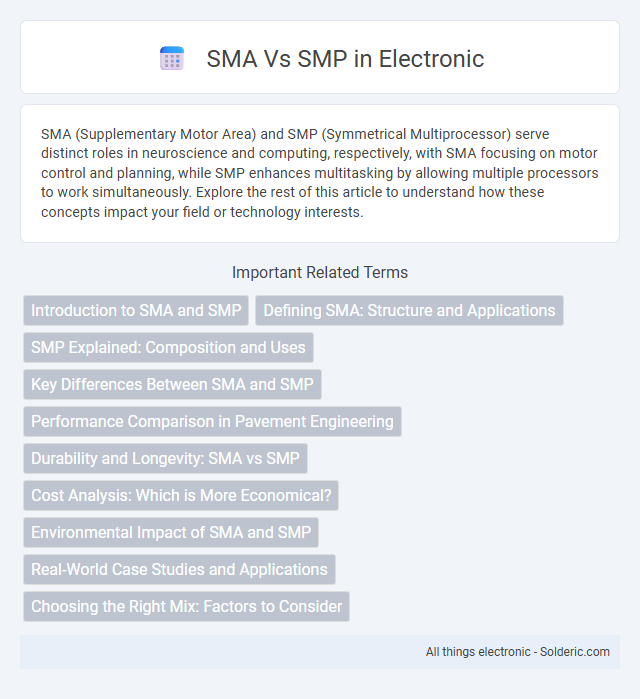SMA (Supplementary Motor Area) and SMP (Symmetrical Multiprocessor) serve distinct roles in neuroscience and computing, respectively, with SMA focusing on motor control and planning, while SMP enhances multitasking by allowing multiple processors to work simultaneously. Explore the rest of this article to understand how these concepts impact your field or technology interests.
Comparison Table
| Feature | SMA (Shape Memory Alloy) | SMP (Shape Memory Polymer) |
|---|---|---|
| Material Type | Metallic Alloy (e.g., Nickel-Titanium) | Polymeric Material |
| Activation Mechanism | Heat or Stress-induced Phase Transformation | Heat, Light, or Solvent Stimuli |
| Recovery Stress | High (up to several hundred MPa) | Low to Moderate |
| Elastic Strain | 6-8% | Up to 200% |
| Density | High (~6.45 g/cm3) | Low (~1-1.5 g/cm3) |
| Cost | Higher | Lower |
| Applications | Medical devices, actuators, aerospace components | Flexible electronics, sensors, biomedical devices |
| Fatigue Resistance | Good | Moderate |
Introduction to SMA and SMP
SMA (Shape Memory Alloy) and SMP (Shape Memory Polymer) are advanced smart materials with the ability to return to their original shapes after deformation. SMA, commonly composed of nickel-titanium alloys, exhibits high strength and excellent thermal recovery, making it ideal for engineering and biomedical applications. SMP offers lightweight and flexible properties suitable for applications requiring large recoverable strains and customizable activation triggers, such as temperature or light.
Defining SMA: Structure and Applications
SMA, or Shape Memory Alloy, is a metallic material that can return to its original shape after deformation when exposed to specific temperatures, due to its unique martensitic and austenitic phase transformations. Its structure consists of a crystalline lattice that changes configuration, enabling applications in actuators, medical devices, and robotics where precise control and flexibility are critical. Your selection between SMA and SMP depends on whether you require metal-like properties with high mechanical strength and temperature-driven shape recovery.
SMP Explained: Composition and Uses
SMP, or Symmetric Multi-Processing, is a computer architecture that uses multiple processors sharing a single, shared main memory and operating under one OS instance, optimizing performance for multitasking and parallel processing. SMP systems typically consist of identical processors connected via a common bus or communication system, enabling efficient workload distribution, fault tolerance, and faster execution of concurrent processes. Commonly employed in servers, high-performance computing, and complex applications, SMP enhances system scalability and reliability compared to single-processor setups.
Key Differences Between SMA and SMP
SMA (Shape Memory Alloy) exhibits phase transformation properties enabling it to return to its original shape after deformation, whereas SMP (Shape Memory Polymer) relies on changes in polymer chain mobility for shape recovery. SMA offers higher strength and faster response times, making it suitable for applications requiring robust mechanical performance, while SMP provides greater flexibility and easier manufacturing options with lower density. The thermal activation temperature ranges differ significantly, with SMA typically activating at higher temperatures compared to SMP's customizable and often lower transition temperatures.
Performance Comparison in Pavement Engineering
SMA (Stone Mastic Asphalt) provides superior rut resistance and durability compared to SMP (Stone Matrix Pavement) due to its optimized aggregate skeleton and high binder content, enhancing load distribution under heavy traffic. SMA's interlocking coarse aggregates improve skid resistance and structural capacity, making it ideal for high-stress pavement layers. Your pavement design can benefit from SMA's enhanced performance in terms of longevity and reduced maintenance costs over SMP.
Durability and Longevity: SMA vs SMP
SMA (Styrene-Butadiene-Styrene Modified Asphalt) offers superior durability due to its high resistance to rutting, cracking, and weathering, making it ideal for heavy traffic areas and harsh climates. SMP (Stone Matrix Asphalt), while also durable, provides enhanced structural integrity by incorporating a dense stone skeleton, ensuring longer lifespan under fluctuating load conditions. Your choice between SMA and SMP should consider the specific environmental stresses and traffic volumes to maximize pavement longevity.
Cost Analysis: Which is More Economical?
SMA (Stone Mastic Asphalt) generally incurs higher initial costs due to its material composition and specialized installation process, while SMP (Stone Matrix Pavement) tends to be more economical with lower upfront expenses and simpler construction requirements. Long-term costs favor SMP as it typically demands less maintenance and repairs compared to the more durable yet pricier SMA. Evaluating overall lifecycle costs reveals SMP as the cost-effective choice for budget-conscious infrastructure projects.
Environmental Impact of SMA and SMP
SMA (Stone Mastic Asphalt) and SMP (Stone Matrix Pavement) differ significantly in their environmental impact, primarily due to their material composition and durability. SMA utilizes high-quality aggregates and polymer-modified binders, resulting in longer-lasting pavements that reduce the frequency of repairs and associated emissions. Your choice of SMA over SMP can contribute to lower lifecycle carbon emissions and better resource efficiency in road construction projects.
Real-World Case Studies and Applications
SMA (Shape Memory Alloy) and SMP (Shape Memory Polymer) both demonstrate unique advantages in real-world case studies across various industries, including aerospace, biomedical devices, and robotics. SMA's high strength and thermal responsiveness make it ideal for actuators and stents, while SMP excels in lightweight, flexible applications such as self-healing materials and deployable structures. Understanding your project's specific requirements for durability, flexibility, and temperature response will guide the optimal choice between SMA and SMP technologies.
Choosing the Right Mix: Factors to Consider
Selecting the ideal concrete mix between SMA (Stone Mastic Asphalt) and SMP (Stone Matrix Pavement) depends on factors such as traffic load, environmental conditions, and desired durability. SMA offers superior rut resistance and durability for heavy traffic areas, while SMP provides excellent flexibility and crack resistance in variable climates. Your project requirements for longevity and maintenance frequency will guide the appropriate choice between these high-performance asphalt mixes.
SMA vs SMP Infographic

 solderic.com
solderic.com